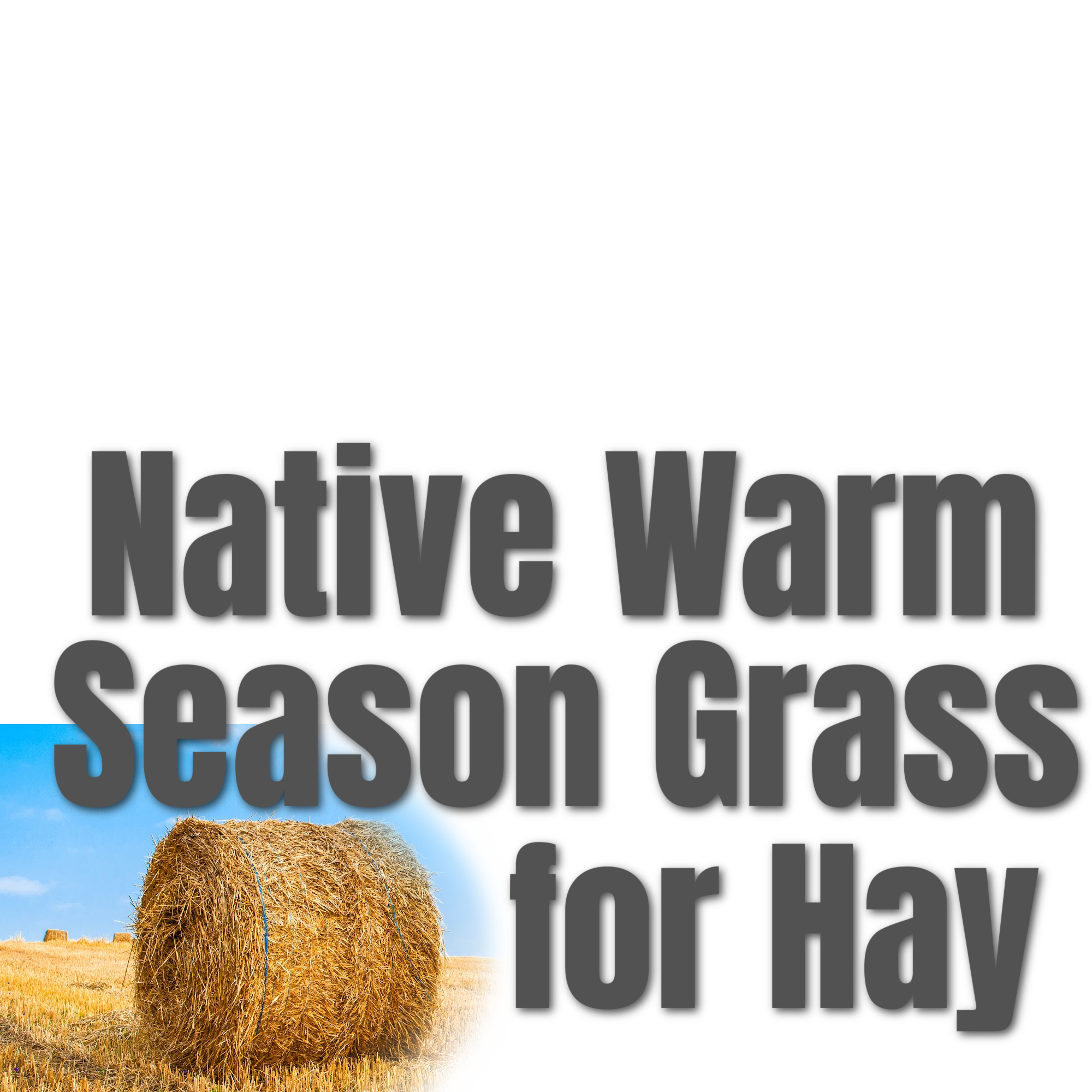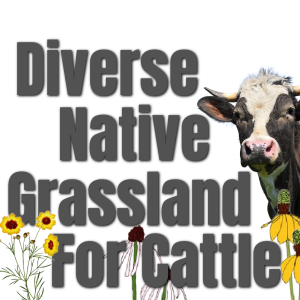Description
Native Warm Season Grasses (NWSG) for Hay
Make hay while the sun shines with Native Warm Season Grasses (NWSG). These grasses, which grow in the summer, make excellent quality hay and yield high tonnages – generally a higher yield than annuals or cool-season perennials. NWSG also produce reliably because they have very good drought resiliency due at least in part to the extremely deep root systems, which can reach 10+ feet when the soil is conducive to such rooting depth. Because NWSG hay is cut and baled in the summer when the days are hot, long, and good for drying hay, it is less likely to be rained on while curing and therefore more likely to hold its quality into the finished bale. The NWSGs have a lower fertility requirement than most hay crops. An added benefit is that NWSG do not have problems with nitrates or prussic acid toxicity.
Here are some excellent choices of NWSG for hay production:
Big Bluestem
With yields of up to 5 tons per acre on a dry matter basis, which converts to 6+ tons per acre of hay yield, Big Bluestem is a good choice for hay ground. This grass is an icon of the tallgrass prairie and savannas. Some sources report that Big Bluestem is the most preferred grass by cattle and bison. This grass does well in soils that are fairly dry to those that are damp – but not saturated. 10 PLS pounds per acre is the seeding rate for a thick stand of Big Bluestem. Make sure to choose varieties adapted to your planting location. Big Bluestem can be established with the help of the Panoramic/Plateau herbicide. For more information on establishment, check out the Panoramic Establishment Plan for Warm Season Grasses Only or contact our Technical Team to discuss if this is a good choice for you.
Indiangrass
This NWSG has yields up to 5 tons per acre on a dry matter basis, which converts to 6+ tons per acre of hay yield. Indiangrass is a very common species in the tallgrass prairie and savannas and it does well in soils that are fairly dry to those that are damp – but not saturated. For a thick, full stand of Indiangrass, the seeding rate is 9.8 PLS pounds per acre. Indiangrass can be established with the help of the Panoramic/Plateau herbicide. For more information on establishment, check out the Panoramic Establishment Plan for Warm Season Grasses Only or contact our Technical Team to discuss if this is a good choice for you.
Mix of Big Bluestem & Indiangrass
Because the timing of cutting hay on these 2 species is similar, they make a great companion planting. The Big Bluestem and Indiangrass are complimentary in that the Indiangrass seedlings establish quickly after a disturbance while the Big Bluestem has more vigorous tillering. A common mix of these two is 7 PLS pounds of Big Bluestem and 3 PLS pounds of Indiangrass per acre. Sometimes, especially on drier sites, Little Bluestem is also included, and a common mix in this case is 6 PLS pounds of Big Bluestem, 3 PLS pounds of Indiangrass, and 1 PLS pound of Little Bluestem per acre. Big Bluestem, Indiangrass, and Little Bluestem can all be established with the help of the Panoramic/Plateau herbicide, for more information on establishment, check out the Panoramic Establishment Plan for Warm Season Grasses Only or contact our Technical Team to discuss if this is a good choice for you.
Switchgrass
(Especially, Alamo, Kanlow, or Cave-in-Rock and potentially RC Big Rock) – Switchgrass can yield 5-8 tons per acre on a dry matter basis, which converts to 6-9.5 tons per acre of hay yield. There are both upland and lowland types of Switchgrass. The Alamo and Kanlow varieties are the lowland type while Cave-in-Rock is an upland type (Blackwell and Nebraska 28 are also upland types, but generally not as productive as the Cave-in-Rock for Missouri and east). RC Bigrock is a selection from Cave-in-Rock. It is common for the lowland types to be used in wetter soils while the upland type is used on drier, more upland sites. Switchgrass can be stemmier than the other NWSG. Also, Switchgrass should be avoided as hay for horses and small ruminants because it contains saponins, which can be toxic for horses and small ruminants, but saponins do not affect cattle. For a full stand of Switchgrass, 6 PLS pounds per acre is the seeding rate. While not tolerant to Panoramic, Switchgrass can be established is Atrazine. For an establishment timeline, check out the Atrazine Establishment Plan for Warm Season Grasses Only or contact our Technical Team to discuss if this is a good choice for you.
Eastern Gama Grass
This NWSG can yield 4-8 tons per acre on a dry matter basis, which converts to 4.8-9.5 tons per acre of hay yield. Many people consider this the “Ice-cream Grass”. Eastern Gama Grass is particularly well suited for poorly drained soils, including claypans but it is widely adapted to other soils as well. Eastern Gama Grass is unique among the NWSG because it can take advantage of very high nitrogen inputs, but while it can make good use of nitrogen and appreciates good soil, nitrogen fertilization is not required. Like the other NWSG, minimal phosphorus is needed. Eastern Gama Grass does have a substantial crown that often sits above the surface of the soil, which can make a field very bumpy for equipment. Some people report that in plantings that are hayed from the beginning, the stand does not develop this rough characteristic and others plant in wide rows to facilitate driving between the crowns. For a full stand of Eastern Gama Grass, 10 PLS pounds per acre is usually sufficient, but a seeding rate of 15 PLS pounds per acre will take less time for the individual plants to canopy. Unlike the other NWSG, Eastern Gama Grass seed has a built-in dormancy and should be planted in the dormant season. Atrazine can be used during the establishment of Eastern Gama Grass.
Order Eastern Gamagrass seed or contact our Technical Team to discuss if this is a good choice for you.
“Prairie Hay”
The native tallgrass prairie, which is famous for its high-quality hay, in many areas is dominated by Big Bluestem, Indiangrass, and Little Bluestem. However, there is so much more diversity in the prairie. Native forbs and legumes (also called wildflowers), native cool season grasses, and other species of NWSG are present in significant amounts.
Please contact us to order a “prairie hay” mix so that our Technical Team can help you customize a mix based on your soils, location, and goals.
A Word on Haying Management:
There are a few things to keep in mind when haying NWSG. First, the standard recommendation is to leave at least an 8-inch stubble height. This protects the growing point of the plants, which contributes to more rapid recovery of the stand following the hay harvest. This higher cutting height results in very little loss of tonnage and the little loss of tonnage that does occur is all stem, not leaf. Second, the timing of hay harvest for NWSG should be at the boot stage – before the emergence of any seedheads. Third, the forage test results consistently underestimate the quality of NWSG hay. Although lab test techniques are good, especially for cool-season forages, they do not exactly replicate what is happening inside the rumen. Studies show that animal performance is much better on NWSG hay than the forage analysis would indicate. Both the digestibility and protein are underestimated by these tests. However, hay that is put up well will produce very high-quality animal performance. For more discussion on all of these points, read Patrick Keyser’s book Native Frass Forages for the Eastern U.S.
More Resources
For more information, check out our blog post “The Rest of the Story on Haying Native Grasses”.
Also be sure to check out our video “Double the Hay with None of the Fertilizer Using Native Warm Season Grasses!”
Additional information
| Cattle Palatability | Good |
|---|




